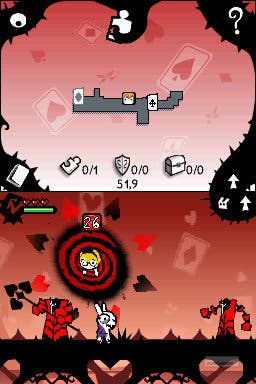Alice in Wonderland
Curiouser and curiouser.
We often talk about videogame bastardisations of films, but games' relationship with literature isn't often pored over - mostly because games rarely dare to engage with, plagiarise or sully written source material with the same wanton abandon.
It's wonderful, then, to see that Etranges Libellules' interpretation of Alice in Wonderland has more to do with Lewis Carroll then Tim Burton; visually, the game draws on Burton's surreal caricature, but its cleverness, humour and wonderful sense of nonsense are true to Carroll's twisted fairytale.
It's beautifully presented from the menu screen onwards, where wide-eyed little Alice chases a purple-jacketed white rabbit down the rabbit hole and into the Underland below. Option screens are hidden behind doors, which you knock upon twice to get Alice to throw them open with visible enthusiasm. Characters are distinctively designed, delineated in thick, Okami-esque ink strokes, and have a visual affinity with Burton's earlier work, if not with the film that's ostensibly its inspiration.
It's the dreamy surrealism of the music and presentation that draws you in, but the deft and creative execution that holds the attention. Alice in Wonderland is a partner-based 2D platform puzzler - mechanically, think LostWinds meets ICO. You control McTwisp, the white rabbit, and Alice skips or runs along behind him, asking for an occasional helping hand to get up a ledge or across a wide gap. Tap her once and Alice stays where she is, staring wide-eyed and slightly gormless around her - leave her alone too long though and a vortex opens up and swallows her.

It's far more than just the usual boring team puzzles - at no point do you have to get one character to stand on a switch while the other runs through a door. Alice and McTwisp are joined, later on, by Absolem the giant caterpillar, Chessur the cheshire cat and the Mad Hatter, and all of them have different ways of interacting with the dreamscape.
McTwisp can manipulate time, reversing it to make a fallen apple leap back to its branch to form a platform, or accelerating it to make roots grow into bridges across gaps. Absolem can reverse gravity at certain points, sending Alice skipping across the ceiling, while the Cheshire cat makes objects appear and disappear, and the Mad Hatter can flip the entire world on its axis, Super Paper Mario-style, to see what's hidden behind.
Each new ability is gently introduced, but they're applied more creatively as the game goes on. Old levels are suddenly full of new opportunities with the discovery of a new power. Puzzles will rarely make you scratch your head for long, but they do make you smile - and so will the script. The game is unexpectedly well-written, full of nonsense and slapstick and even the occasional laugh-out-loud moment.

